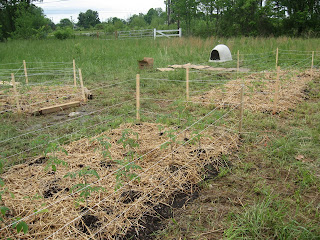 On May 22nd, the turkeys arrived! Ordering the hatchery's choice of heritage turkeys, we received 38 healthy poults that all appear to be Blue Slates. When they arrived at the dawn of their third day, some even had the tips of their primary feathers emerging.
On May 22nd, the turkeys arrived! Ordering the hatchery's choice of heritage turkeys, we received 38 healthy poults that all appear to be Blue Slates. When they arrived at the dawn of their third day, some even had the tips of their primary feathers emerging.

So far, the turkeys are my favorite. They're so much calmer and quieter than the chickens, which are still running and screaming from me when I enter their enclosure. Turkeys have a reputation as being rather dumb youngsters. Sometimes, apparently, some fail to begin to eat and drink and die shortly thereafter. Legend also has it that young turkeys will drown if placed outside too early and it rains, looking skyward with their mouths agape. But after watching these little guys for only a week now - and talking with Jen, John, Mary and Scott - I've been thinking about how this so-called stupidity of turkeys might actually be the first stage of intelligence. Compared to chickens, whose consumptive instincts are seemingly stronger from the outset, turkeys must be shown where and how to eat and drink. They need to be imprinted upon, in other words, and this may be an early point of differentiation for learning and adaptation. Just some beginning thoughts.


But one of the other reasons I so like the turkeys is their symbolic connections to our national identity. As John reminded me, Ben Franklin supported the idea of the turkey - over that of the Bald Eagle - for the national bird. As the story goes, during the Revolutionary War a regiment of soldiers flew the Bald Eagle insignia Congress eventually adopted as the national seal, but drew it so badly that it looked like a turkey. Franklin used this likeness to compare the two birds, lamenting the ultimate choice in a letter to his daughter from Paris in 1784:
"For my own part I wish the Bald Eagle had not been chosen the Representative of our Country. He is a Bird of bad moral Character. He does not get his Living honestly. You may have seen him perched on some dead Tree near the River, where, too lazy to fish for himself, he watches the Labour of the Fishing Hawk; and when that diligent Bird has at length taken a Fish, and is bearing it to his Nest for the Support of his Mate and young Ones, the Bald Eagle pursues him and takes it from him.
"With all this Injustice, he is never in good Case but like those among Men who live by Sharping & Robbing he is generally poor and often very lousy. Besides he is a rank Coward: The little King Bird not bigger than a Sparrow attacks him boldly and drives him out of the District. He is therefore by no means a proper Emblem for the brave and honest Cincinnati of America who have driven all the King birds from our Country...
"I am on this account not displeased that the Figure is not known as a Bald Eagle, but looks more like a Turkey. For the Truth the Turkey is in Comparison a much more respectable Bird, and withal a true original Native of America....He is besides, though a little vain & silly, a Bird of Courage, and would not hesitate to attack a Grenadier of the British Guards who should presume to invade his Farm Yard with a red Coat on."
Plus, you can eat turkeys. And they have really cool heads.

















